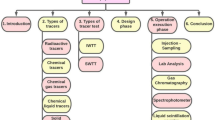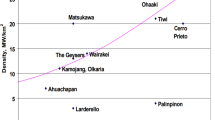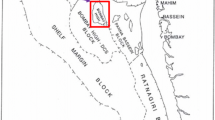Abstract
The tracer test has become one of the most important methods to determine the hydraulic connection between injection and production wells in a geothermal reservoir. Various chemicals such as fluorescein, radioactive chemicals, salts, and alcohols are used as tracers in geothermal systems. Breakthrough curves of chemical concentrations are matched with analytical models to identify the most representative reservoir model and to obtain important reservoir parameters such as swept pore volume, average fluid velocity, and dispersivity. In this study, we have used sodium fluorescein as a tracer to understand the reservoir characteristics of the Salihli geothermal field in Western Anatolia. The hydraulic connectivity between injection and production wells was identified. The study aimed to determine the most representative reservoir model for Salihli geothermal reservoir. The nonlinear least square method was applied to obtain matches between the analytical models and actual field data. The most representative model was found by evaluating the sum of the square residual. The study includes moment analysis, Dkystra-Parsons, and Lorentz coefficients for reservoir characterization. The study also used flow-capacity and storage-capacity relation to quantify reservoir characteristics for different parts of the reservoir. Fluid velocity in the Salihli geothermal reservoir changes between 2.8 and 19.2 m per hour. Calculated swept pore volume was found between 2 to 13 thousand cubic meter between injection and production wells.












Similar content being viewed by others
Abbreviations
- A :
-
Cross-sectional area of a spring (m2)
- \({{A}_{b}}_{d}\) :
-
Absorptivity of dye sample (dimensionless)
- \({{A}_{b}}_{s}\) :
-
Absorptivity of dye at 100% strength (dimensionless)
- α f :
-
The rate of tracer interchange per unit fracture volume (1/s)
- α m :
-
The rate of tracer interchange per unit matrix volume (1/s)
- C :
-
Peak concentration (mg/m3)
- C calculated :
-
Calculated tracer concentration (mg/m3)
- C measured :
-
Measured tracer concentration (mg/m3)
- C p :
-
Expected peak tracer concentration (mg/m3)
- C o :
-
Initial (stock) dye concentration (g/L)
- C t :
-
Tracer concentration estimated by transfer function (mg/m3)
- C r :
-
Tracer concentration (mg/m3)
- D z :
-
Axial diffusion constant (m2/h)
- e i :
-
The flow contribution coefficient (dimensionless)
- F :
-
Flow capacity (dimensionless)
- I l :
-
The modified Bessel function of the first kind of order
- J :
-
Model parameter (dimensionless)
- k :
-
Cross-sectional area (m2)
- L :
-
Expected tracer transport distance (m)
- l :
-
Length for individual flow paths (m)
- L c :
-
Lorentz coefficient
- M :
-
Calculated tracer mass to inject (g)
- m :
-
The mass of tracer entering the stream tube (g)
- μ :
-
Tracer decay (1/h)
- n :
-
The number of flow channels in the fracture system (dimensionless)
- n e :
-
Effective porosity (dimensionless)
- P ei :
-
Peclet number (dimensionless)
- P emf :
-
Peclet number corresponding to the ratio of tracer transport by advection to tracer transport by diffusion (dimensionless)
- P eup :
-
Peclet number (dimensionless)
- Ppb :
-
Parts per billion = 1 mg/m3
- φ :
-
Storage capacity (dimensionless)
- Q 1 :
-
Well or spring discharge (m3/h)
- Q :
-
Volume production rate (m3/s)
- Q inj :
-
Injection rate, m3/s
- R :
-
The objective function for non-linear-least-squares approximation
- R d :
-
Tracer retardation (dimensionless)
- R i :
-
Apparent fracture length, m
- T ρ :
-
Tracer density (g/cm3)
- T p :
-
Tracer purity (g/g)
- t :
-
Sampling time (s)
- \(\overline{t }\) :
-
Mean tracer travel time (h)
- t m , t r :
-
Mean arrival time (s)
- t b :
-
The response start time at which the pulse would reach the observation well if there was no diffusion (s)
- t* :
-
Mean residence time (s)
- t p1 :
-
Expected time to peak tracer arrival (h)
- t p :
-
Peak concentration time (s)
- U :
-
Heaviside step distribution
- u i :
-
Average velocity (m/s)
- v :
-
Average velocity (m/h)
- v p :
-
Expected velocity for peak-tracer migration (m/s)
- V p :
-
Swept pore volume, m3
- V DP :
-
Dykstra-Parsons coefficient
- w :
-
The ratio of transport along the fracture to transport out of the fracture
- z :
-
Expected tracer transport distance (m
References
Akin S (2001) Analysis of tracer tests with simple spreadsheet models. Comput Geosci 27(2):171–178. https://doi.org/10.1016/S0098-3004(00)00084-4
Akin S (2003) Integrated nonlinear regression analysis of tracer and well test data. J Petrol Sci Eng 39(1–2):29–44. https://doi.org/10.1016/S0920-4105(03)00038-X
Akın S, Parlaktuna M, Sayık T, Sezer H, Karahan C, Bakrac S (2010) Interpretation of the Tracer Test of Balçova Geothermal Field. Proceedings World Geothermal Congress 2010 Bali, Indonesia, 25–29 April 2010
Atashbeyk MD, Shahbazi K, Fattahi M (2018) Pressure Profile Estimation through CFD in UBD Operation Considering with Influx to Wellbore. https://doi.org/10.30492/ijcce.2018.30127
Axelsson G (2013) Tracer tests in geothermal resource management. Proc EPJ Web of Conferences 50:02001–1–2008
Aydin H (2018) Discrete Fracture Network Modeling Of Alaşehir Geothermal Field. Middle East Technical University
Aydin H, Akin S (2020) Analysis of a Comprehensive Tracer Test in Alaşehir Geothermal Field. Turkey IV. Scientific and Technical Petroleum Congress, 18–20 November 2020, Ankara, Turkey
Bagherzadeh A, Shahbazi K, Fattahi M, Gerami S (2017) Investigating the applicability and effects of hydraulic fracturing technology on well productivity in one of the Iranian gas condensate reservoirs. Carbon Evap 33:637–650
Bauer JF, Krumbholz M, Meier S, Tanner DC (2017) Predictability of properties of a fractured geothermal reservoir: the opportunities and limitations of an outcrop analogue study. Geothermal Energy 5(1):24. https://doi.org/10.1186/s40517-017-0081-0
Bjarkason EK (2014) Predicting Thermal Drawdown in Geothermal Systems Using Interwell Tracer Tests. University of Iceland
Bullivant DP (1988) Tracer Testing of Geothermal Reservoirs. University of Auckland
Bullivant DP, O’sullivan MJ (1989) Matching a field tracer test with some simple models. Water Resour Res 25(8):1879–1891. https://doi.org/10.1029/WR025i008p01879
Cao V (2018) Tracer compounds in geothermal reservoirs: Improving the outcome quality of a tracer test. Universität Göttingen
Çiftçi NB, Bozkurt E (2009) Structural evolution of the Gediz Graben SW Turkey: temporal and spatial variation of the graben basin. Basin Res. https://doi.org/10.1111/j.1365-2117.2009.00438.x
Drew DI, Smith DI (1969) Techniques for the tracing of subterranean drainage. British Geomorphol Res Group Tech Bull 2
Emre T (1996) Geology and the tectonics of the Gediz Graben. Turk J Earth Sci 5(3):171–185
Faulds JE, Bouchot V, Moeck I, Oguz K (2009) Structural controls on geothermal systems in Western Turkey: A Preliminary report. GRC Transact 33:375–381
Field MS (2003) A review of some tracer-test design equations for tracer-mass estimation and sample-collection frequency. Environ Geol 43(8):867–881. https://doi.org/10.1007/s00254-002-0708-7
Fossum MP, Horne RN (1982) Interpretation of tracer return profiles at Wairakei geothermal field using fracture analysis. Geothermal Resour Council Transact 6:261–264
Grant MA, Bixley PF (2011) Geothermal Reservoir Engineering. Academic Press
Hacıoğlu Ö, Başokur AT, Diner Ç (2021) Geothermal potential of the eastern end of the Gediz basin, western Anatolia, Turkey revealed by three-dimensional inversion of magnetotelluric data. Geothermics 91:102040
Heidari M, Shahbazi Khç, Fattahi M (2017) Experimental study of rheological properties of aphron based drilling Fluids and their effects on formation damage. https://doi.org/10.24200/SCI.2017.4108
Howell JA, Martinius AW, Good TR (2018) The Application of Outcrop Analogues in Geological Modelling: A Review. Geological Society, London, Special Publications, Present Status and Future Outlook, p 387
Kilpatrick FA, Wilson JF (1989). Measurement of time of travel in streams by dye tracing. https://doi.org/10.3133/twri03A9
Lai J, Wang G, Wang S, Cao J, Li M, Pang X, Han C, Fan X, Yang L, He Z, Qin Z (2018) A review on the applications of image logs in structural analysis and sedimentary characterization. Mar Pet Geol 95:139–166. https://doi.org/10.1016/j.marpetgeo.2018.04.020
Lake LW (1989) Enhanced Oil Recovery. Prentice Hall
Mattson E, Plummer M, Palmer C, Hull L, Miller S, Nye R (2011) Comparison of Three Tracer Tests At The Raft River Geothermal Site. PROCEEDINGS, Thirty-Sixth Workshop on Geothermal Reservoir Engineering Stanford University, Stanford, California, January 31 - February 2, 2011 SGP-TR-191
Ozen T (2009) Hydrogeological and Hydrogeochemical Studies of the Salihli Geothermal Fields. Dokuz Eylul University, Izmir
Ozen T, Bulbul A, Tarcan G (2010) Reservoir and Hydrogeochemical Characterizations of the Salihli Geothermal Fields in Turkey. Proceedings World Geothermal Congress 2010 Bali, Indonesia, 25–29
Ozen T, Bülbül A, Tarcan G (2012) Reservoir and hydrogeochemical characterizations of geothermal fields in Salihli, Turkey. J Asian Earth Sci 60:1–17. https://doi.org/10.1016/j.jseaes.2012.07.016
Ozen T, Bülbül A, Tarcan G (2017) Review of water and soil contamination in and around Salihli geothermal field (Manisa, Turkey). Arab J Geosci 10(23):523. https://doi.org/10.1007/s12517-017-3299-z
Purvis M, Robertson A (2005) Sedimentation of the Neogene-Recent Alaşehir (Gediz) continental graben system used to test alternative tectonic models for western (Aegean) Turkey. Sed Geol 173(1–4):373–408. https://doi.org/10.1016/j.sedgeo.2003.08.005
Sauty J-P (1980) An analysis of hydrodispersive transfer in aquifers. Water Resour Res 16(1):145–158. https://doi.org/10.1029/WR016i001p00145
Shook GM (2003) Simple, Fast Method of Estimating Fractured Reservoir Geometry from Tracer Tests. Transact Geothermal Resour Council 26:407–411
Shook GM (2005). A Systematic Method for Tracer Test Analysis: An Example Using Beowawe Tracer Data. Proceedings,Thirtieth Workshop on Geothermal Reservoir Engineering Stanford University, Stanford, California, January 31-February 2, 2005 SGP-TR-176
Shook GM, Ansley SL-AW (2004) Tracers and Tracer Testing: Design, Implementation, and Interpretation Methods
Sozbilir H (2002) Geometry and origin of folding in the Neogene sediments of the Gediz Graben, western Anatolia. Turkey Geodinamica Acta 15(5–6):277–288. https://doi.org/10.1016/S0985-3111(02)01093-8
Wang L, Zuo L, Zhu C (2020) Tracer Test and Streamline Simulation for Geothermal Resources in Cuona of Tibet. Fluids 5(3). 10.3390/fluids5030128
Warren JE, Root PJ (1963) The Behavior of Naturally Fractured Reservoirs. Soc Petrol Eng J 3(03):245–255. https://doi.org/10.2118/426-PA
Watson A (2013) Geothermal Engineering. Springer, New York. https://doi.org/10.1007/978-1-4614-8569-8
Zarrouk SJ, McLean K (2019) Geothermal Well Test Analysis. Elsevier. https://doi.org/10.1016/C2017-0-02723-4
Author information
Authors and Affiliations
Corresponding author
Ethics declarations
Conflict of interest
On behalf of all authors, the corresponding author states that there is no conflict of interest.
Additional information
Publisher's Note
Springer Nature remains neutral with regard to jurisdictional claims in published maps and institutional affiliations.
Rights and permissions
About this article
Cite this article
Aydin, H., Balaban, T.Ö., Bülbül, A. et al. Determining the most representative reservoir model for the shallow depth salihli geothermal reservoir in Turkey using tracer test. Heat Mass Transfer 58, 1105–1118 (2022). https://doi.org/10.1007/s00231-021-03166-y
Received:
Accepted:
Published:
Issue Date:
DOI: https://doi.org/10.1007/s00231-021-03166-y




